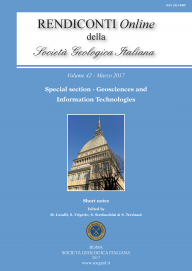
Influence of digital terrain model on mapping of slope deposits depth
Michele Pio Papasidero (a), Emanuele Trefolini (a), Vincenzo Vacca (a), Federico Viti (a) & Leonardo Disperati (a,b)
(a) Dipartimento di Scienze Fisiche, della Terra e dell'Ambiente, Università di Siena, Strada Laterina, 8, 53100, Siena, Italia.
Corresponding author e-mail: michele.papasidero@unisi.it.
(b) Istituto di Geoscienze e Georisorse (IGG-CNR), Pisa, Italia.
Volume: 42/2017
Pages: 34-37
Abstract
In this work the influence of the characteristics of different Digital Terrain Models (DTMs) on Slope Deposits depth (dSD) maps is evaluated. dSD data collected during fieldwork have been mapped through GPS. Two different DTMs have been used for the analysis: one derived from LiDAR survey (1 m pixel size), the other extracted by the topographic maps of Regione Toscana (10 m pixel size). dSD maps have been extracted by integrating cluster analysis of morphometric variables with dSD data. In order to investigate the effects of spatial resolution, the LiDAR DTM has been down-sampled to both 5 m and 10 m. The weight of GPS positioning uncertainty has been assessed by performing a statistical analysis on the morphometric clusters falling into buffer areas of sampling points. Comparisons among outputs have been performed through map accuracy estimations, as well as by spatial distribution visual check and extension assessment of dSD classes. Results show that by increasing spatial resolution of input DTMs the statistical quality of the dSD maps generally reduces. Concerning the effect of buffer size around sampling points, as a general rule, the larger the buffer, the lower the map accuracy. Only the map obtained by 1 m LiDAR DTM is insensitive to buffer size.
Keywords
Get Full Text